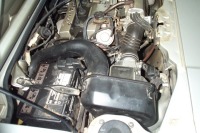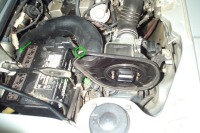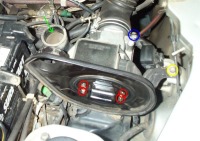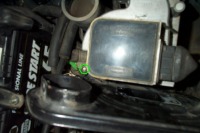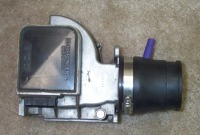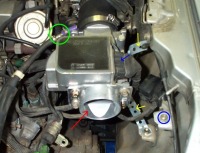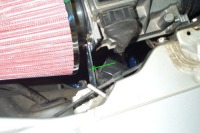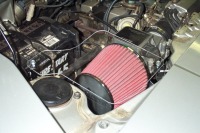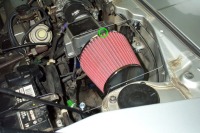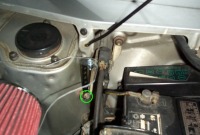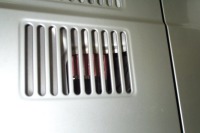
Intake Filter Mod*Applies mainly to 85-86 NA MR2s. 87+ MR2s have their Intake filter mounted in the trunk. However, if you wish you can follow this writeup & move the filter into the engine bay like the 85/6s. This is a very common modification for the MKI MR2s and usually the first people do. The stock air filter setup is quite restrictive to airflow. There are quite a bit of writeups for this one, but hopefully I can provide you with more detailed pictures for performing the mod. Things may be slightly different for newer year MKIs. Results after doing this include faster revving & a louder note from the engine above 3000 rpm and this mod has been dyno'd (not by me and my setup though) and showed about a 5HP peak increase in the upper rpm band. One thing I did notice, is that there is a slight buzzing from the intake between 4000-4200 rpm. Nothing to worry about though, it's just resonate frequency being induced into the system from removing the factory resonator box. Here's what you need to do the basics (there are a few places that sell the entire kit online, particularly Ebay., I went the separate purchases route myself):
Total cost is around $50.
Removal 1) Here's the stock setup. Begin by removing the air filter & its cover:
2) Remove the snorkle, by removing the 10mm bolt and unclipping it from behind the battery.
3) Pull the hose pointed to by the green arrow up and out. Unbolt the 4 10mm bolts (red circles). Remove the yellow & blue circled 10mm bolts. You need to remove the blue circled bolt for when you pull the air filter plate and resonator box out. Here's another bolt that you need to remove: And another:
4) Now all that junk should be out. Next is removing the AFM. Remove the bracket by undoing the green circled bolt. Remove the AFM wiring plug in the red box. To do this take a small flat-tip screwdriver to pull the clip in the direction the yellow arrow is pointing. The plug should then pull straight out. Loosen the blue circled bolt holding the hose onto the AFM.
5) Loosen the bolt (green circle) for the hose clamp holding the hose to the TPS. Also, remove the AC idle-up line (if you have AC) by loosening the hose clamp (red circle) with a pair of pliers. Note: Since you have gone this far in the process, you will notice a nice coating oily residue inside the throttle body and on the butterfly valve. If you would like more info and pictures of cleaning out the TB check out my TB & TPS page.
6) Now here's all the crap that you have just removed and will not be putting back into the car: And here's the newer, simpler system that's going in:
Install 1) Place the 2" coupling onto the AFM. This is the toughest part of the whole process. You will need to work the coupling so that it will stretch over the AFM. I found that by inserting a pair of pliers and pulling the handles apart was an easy way to stretch the coupling. After doing this for a minute or so, putting the coupling on the AFM was quite easier. Tighten down the hose clamp.
2) If you do not have AC, go to step 3. Now you will need to tap into the coupling with the fitting that you decided upon. (You could also tap into the AFM itself to use a screw type fitting, but I do not have the tools to do this). I used a tiny Phillips screwdriver to start my hole, and gradually made the hole bigger until it was a real tight fit with the fitting. Here's the AFM with a purple hose attached to the other end of the fitting. And here's a view looking into the AFM, you can see the brass fitting:
3) Connect the AFM back to the TPS, using the circled hose clamp. Ignore the bracket pointed to by the red arrow. I put it there to temporarily support the weight of the AFM
4) Lots of steps here. Connect the AC idle up lines in green circle (if you have AC), attach the AFM adapter pointed to by red arrow by four 10mm bolts, fabricate some brackets (I redid this with strong metal, see the bottom of this page for the new ones), connect the AFM plug (blue arrow) and the diagnosis plug bracket (blue circle).
5) Finally, attach the filter and tighten the circled hose clamp.
Also, find a place to attach the VSV that the AC idle-up line isconnected to. Mine is temporarily twist-tied to something else, until I get a longer piece of silicone hose.
Rainshield & Better Brackets To make the AFM & Filter alot stiffer, I redid the brackets from some stiffer aluminum stock pieces. The first one is attached to the bottom of the decklid release bracket and to the back side of the AFM: The other bracket attaches with bolt & nut to a hole, found under the bracket for the diagnosis plug, and to the AFM adapter plate.
And finally the finished setup with the rainshield made out of plain old clear plexiglass, cut with a Rotozip and smoothed with a file. Here's another view. Circled is a piece of green felt, as the plexiglass contacts the top of the filter. This stopped some vibration and possibly scratching of the plexiglass. Here's how I did the brackets for the plex. To remove the plex, it only takes the removal of the below circled bolt. The other bracket is just slid over the decklid prop rod rest pin. This way you don't have to mess with touching the bolts that attach the brackets to the plex. (In the below picture you can see where the metal bracket attaches to the AFM adapter plate.) And here's why you need the rainshield:
Jan 3, 2002 Replaced temporary vacuum hose with a longer piece (about 5") and remounted VSV properly to where the battery sits. Also, here's how I have to store the prop rod when the engine lid is down. |
|
| Home • Links •
Email Disclaimer: This web page in no way replaces
the MR2 repair manual. Follow what it says before me. The purpose of
this page is to give you a better pictorial description of what to do.
I cannot be held responsible for any mishaps caused by this web page.
|

